
Is everyone excited about this weekend’s expedited Synopsispalooza schedule, or, as I like to think of it, the Saturday and Sunday of Synopses? In this morning’s post, I provided you with concrete examples of 5-, 3-, 2-, and 1-page synopses for the same story, so you might see the different level of detail expected in each, as well as how the content selection and tone might be varied to fit the story into a couple of other book categories.
To that noble end, I borrowed from a story most of you were likely to know, a little number called THE TRAGEDY OF HAMLET, PRINCE OF DENMARK, by an up-and-coming writer named William Shakespeare. This evening, I am going to use that same storyline to come up with examples of 1-, 3-, and 5-page synopses for memoir.
Hey, if you weren’t familiar with it before this morning’s post, you’ve certainly seen enough versions of it to be conversant with it now, right?
Why go over memoir synopses in their own post, since a savvy memoirist could use the same storytelling techniques as a novelist does to shape a compelling narrative? (For some tips on how to pull that off, please see my previous Synopsispalooza post on the subject.) Several reasons, actually.
First, as I mentioned in this morning’s post, the vast majority of aspiring writers in general — and, it’s safe to conclude, first-time memoirists in particular — have never seen a professional synopsis for their type of book. As, indeed, I surmised from plaintive-yet-practical questions like the following, posted by intrepid memoirist Pamela Jane on an earlier Synopsispalooza installment:
Is there any place where we can view an successful memoir synopsis? That would be wonderfully helpful.
As an experienced writing teacher, I make bold to interpret requests like this as an indication that I might not have been generating enough practical examples of late. Surely, that alone would make for an excellent second reason to devote an entire post to making up the shortfall. (And don’t worry, nonfiction-synopsizers who do not write memoir: I shall be churning out concrete examples for you tomorrow a.m.)
Third, and perhaps most important for instructive purposes, while memoir synopses share basic formatting and goals with novel synopses — chant them with me now, campers: any synopsis should be in standard manuscript format, and the primary purpose of a query or submission synopsis is not to summarize the book so well that every question is answered, but to prompt Millicent the agency screener to ask to see the manuscript — there are some essential differences. To name but three:
(1) A memoir synopsis should be written in the past tense, whereas a novel synopsis should be written in the present tense.
(2) A memoir synopsis should be written in the first person singular, whereas a novel synopsis should be written in the third person, regardless of the narrative voice of the book.
(3) A memoir synopsis should tell the story of the book in standard manuscript format, without special formatting for the introduction of new characters, whereas a novel synopsis should alert the reader to the first appearance of a character (but only the first) by presenting his name in all capital letters, preferably followed by his age in parentheses.
I suspect that none of those will come as a complete surprise to any of you memoirists out there, but as I’m not entirely sure whether I’ve covered #3 explicitly in a previous Synopsispalooza posts (hey, cut me some slack — do you have any idea how many pages of text it has already run?), let’s talk about it now. Although the capitalization convention is specific to fiction, Millicents (and their contest-judging aunts, Mehitabels) do frequently see memoir synopses with characters introduced as JOAN OF ARC (19). Heck, they occasionally break open submission envelopes to encounter memoirists introducing themselves as I, ARNETTE (7 at the beginning of the story).
That’s neither necessary nor expected in a memoir synopsis. Thus, while a memoir synopsis would mention that Milton Sedgwick sat next to me in my first-grade class. Evidently, he intended to major in yanking my pigtails, a novel synopsis might herald ol’ Milton’s advent in the story with MILTON SEDGWICK (6) devoted our first-grade year to yanking Janelle’s pigtails.
Yes, yes, I know: some of you have probably heard otherwise, but having sold a couple of memoirs, I know whereat I speak. Trust me, both Millicent and Mehitabel may be relied upon to understand that the perpendicular pronoun appearing frequently throughout the memoir synopsis refers to the author/protagonist; neither is at all likely to confuse you with your constantly-weeping track coach or your sociopathic sister just because you haven’t capitalized their names on the synopsis page.
Everybody clear on that? Please chime in with questions, if not; I would hate to have Millicent or Mehitabel perplexed by a half-capitalized set of characters on the synopsis page.
The fourth reason — yes, I’m still justifying, thanks — is the first cousin the first: since very few aspiring writers ever get a chance to take a peek at a professionally-formatted synopsis, some of you might not be aware that under no circumstances should a synopsis of any length be in business format. Or, to put it in terms every user of e-mail can understand, unless an agency’s guidelines, requested materials letter, or contest’s rules specifically ask you to include your synopsis in the body of an e-mail, a synopsis should NEVER be single-spaced, devoid of indentation at the beginning each paragraph, block-justified (i.e., with straight margins on both the left and right sides of the page), or contain a skipped line between paragraphs.
Again, is everybody clear on why that is the case? Not all aspiring writers are: Millicent and Mehitabel shake their heads on a daily basis at synopses formatted as though the writer were unaware (as is, indeed, often the case) that indenting paragraphs is not optional in English prose. Save the non-indented paragraphs and single-spacing for business letters and e-mail, where such barbaric practices belong.
Don’t you tell me that a query letter is a business letter. Part of presenting yourself professional entails adhering to the formatting standards of the industry you are seeking to join. Believe me, the fine folks who work in agencies and publishing houses think of their business as exceptional.
So what should a properly-formatted memoir synopsis look like, whether it will be gracing a query packet, livening up a submission packet, or increasing your chances of winning in a contest entry? A little something like this 5-page synopsis for HAMLET — written, for your educational pleasure, from the melancholy Dane’s own point of view. (As always, if you are having trouble making out the individual words, try holding down the COMMAND key while pressing + to enlarge the image.)
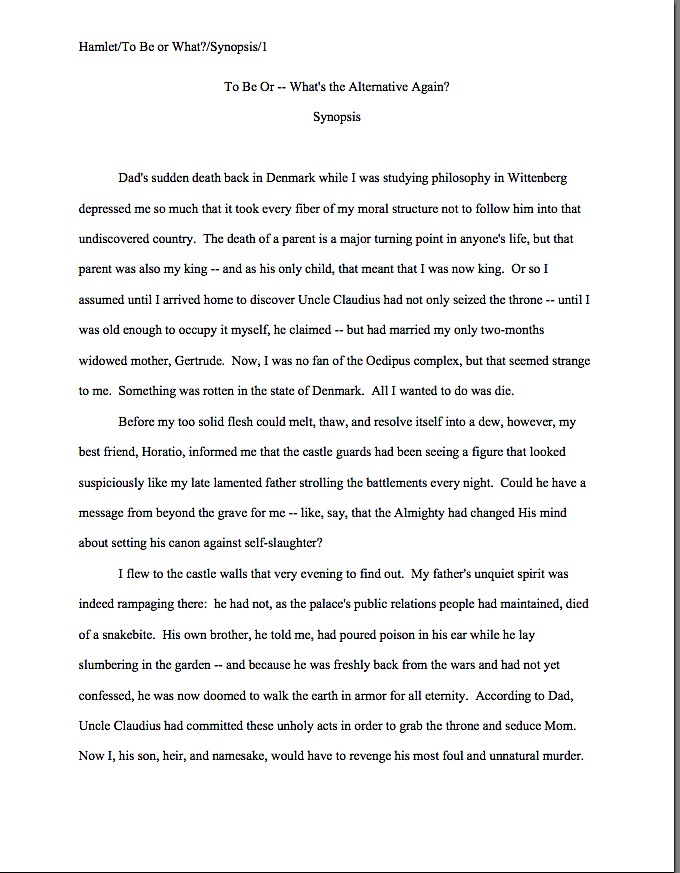
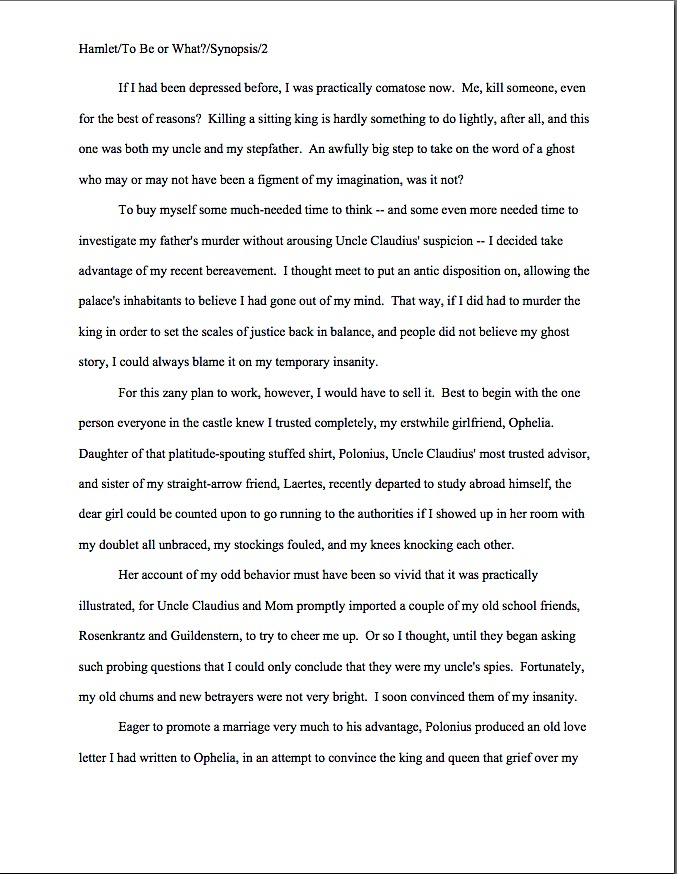
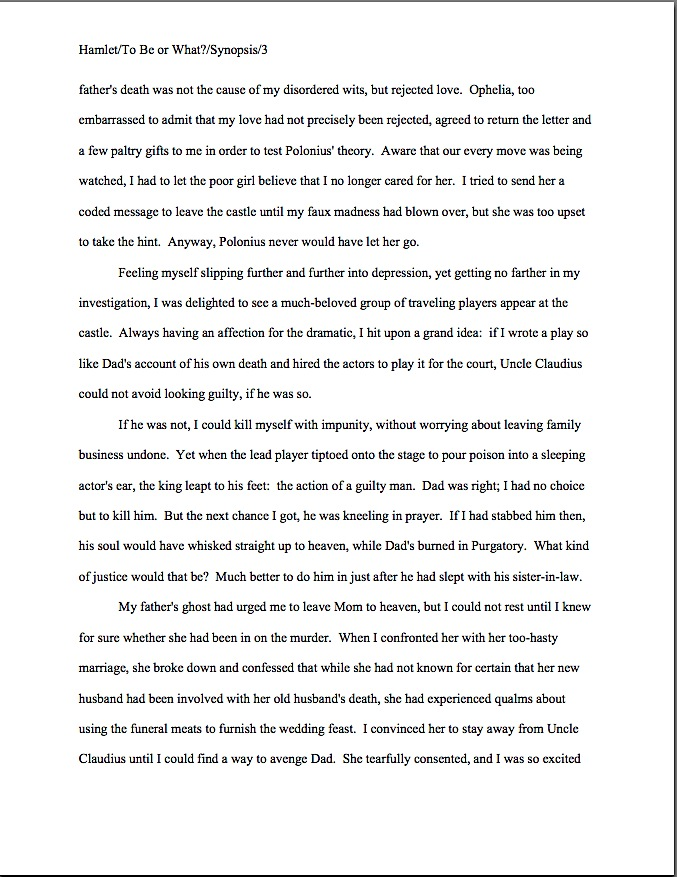
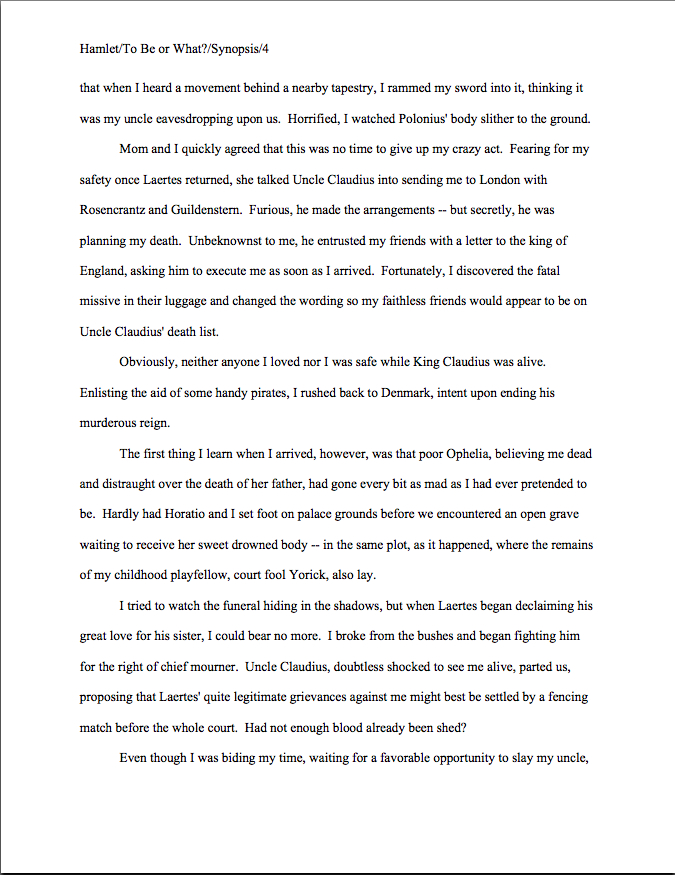
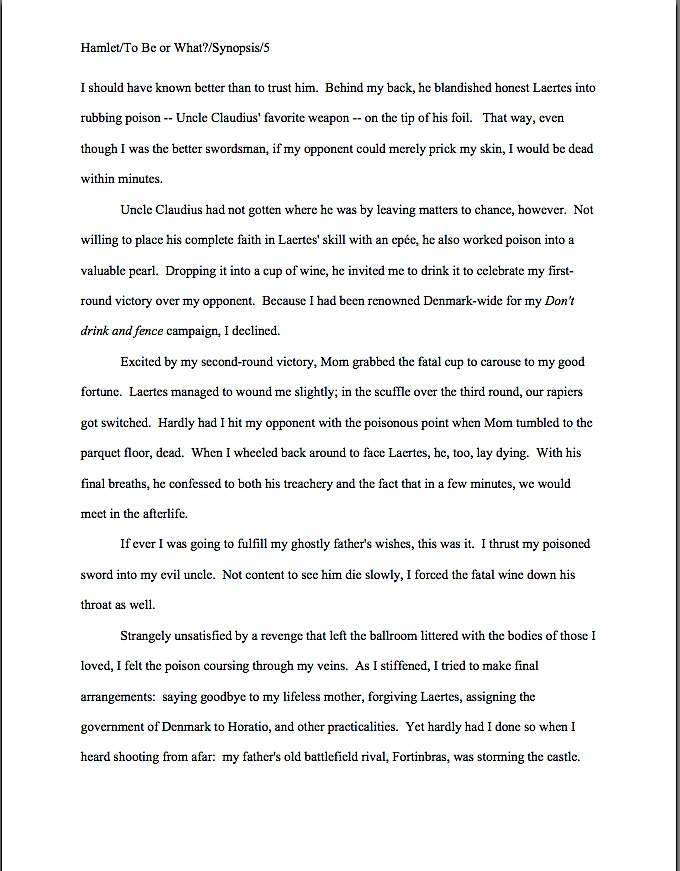
See how easy it would be for Millicent to tell from a quick glance at the first couple of lines that this is a synopsis for a memoir, not a novel? Or for Mehitabel to notice that an entry in the memoir category of her contest had accidentally ended up in the fiction category pile?
While we’re straining our eyeballs, trying to read like these two worthy souls, did anyone catch the gaffe on page 4? (Hint: it’s in the first line of the third full paragraph.)
Spot it now? To Millicent or Mehitabel, it would be fairly obvious what happened here: this synopsis was originally written as if it were for a novel, in the present tense. In the rush to change it over to the proper presentation for a memoir — possibly because the writer had only just learned that the past tense was proper for memoir synopses — one verb got missed.
And what’s the best preventative for that kind of Millicent-annoyer, campers? That’s right: reading your synopsis IN ITS ENTIRETY, IN HARD COPY, and OUT LOUD before you stuff it into an envelope or hit the SEND button.
As you may see, a 5-page synopsis (or the rare one that’s even longer) permits the memoirist to tell his story in some fairly complete detail. Like the novel synopsizer, he’s usually better off describing individual scenes within the story than simply trying to summarize huge chunks of activity within just a few quick sentences.
The same principle applies to the 3- or 4-page synopsis. Obviously, though, since there’s less room, Hamlet can describe fewer scenes:

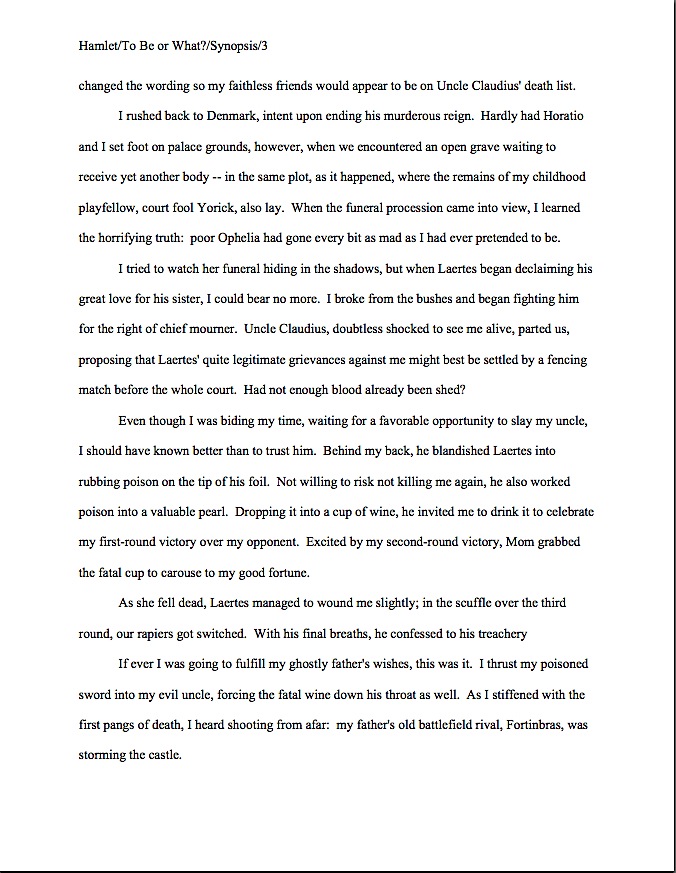
Admittedly, there are a few more summary statements here — the first paragraph contains a couple of lulus — but for the most part, this synopsis is still primarily made up of descriptions of scenes, not just hasty summaries of activity. Cause and effect remain clear. Notice, too, that the sentence structure varies throughout: none of the repetitive X happened and Y happened and Z happened that dog the average mid-length synopsis here.
As we saw in this morning’s post, quite a different strategy is required to pull off the dreaded 1-page synopsis. Here, our boy is going to have to rely pretty heavily on summary statements — but that does not mean specificity need be abandoned altogether.
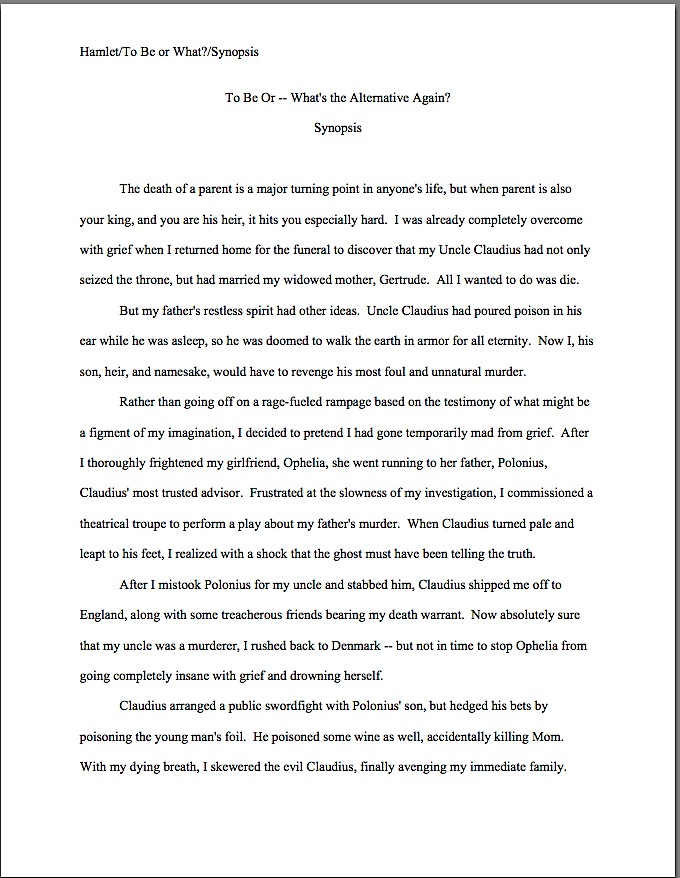
Still a pretty gripping yarn, isn’t it? That’s because Hamlet managed to retain the essential story arc, even when forced by length restrictions to jettison most of the scenes upon which his longer synopses rested.
If you’re still having trouble either seeing the difference between these levels of detail and/or are having trouble translating from theory into practice, don’t start out trying to synopsize your own book. Pick a story you know very well and try writing 5-, 3-, and 1-page versions of it. Repeat as often as necessary until you get the hang of it, then go back to your own opus.
Hey, writing a synopsis is a learned skill. What made you think you would be good at it without some practice?
Why start with somebody else’s book, you ask? If you’re not close to the story, it’s often easier to catch its essence — and that goes double if your story actually is your story.
Remember, the key to writing a great memoir synopsis of any length is to treat yourself as the most interesting character in the most interesting story in the world. Tell that story — but don’t leave either why you are fascinating or why your situation is compelling to Millicent or Mehitabel’s imagination. Make sure both show up on the page.
Hey, if Hamlet can compellingly retell the five-hour play of his life in 5-, 3-, and 1-page versions, so can you. Join me tomorrow for some nonfiction synopsis examples, and keep up the good work!
I realize I’m probably overthinking again, but I had to ask: in a synopsis – at least those more than one page – it is acceptable to have paragraphs with fewer than three sentences?
This was a fascinating post, not the least of which because the story used as illustration is for a rather large story, giving hope to those who might have longer-ish works. 🙂
You do seem to be overthinking a bit, Adam, but the answer is yes. Actually, your question made me smile, because I hadn’t realized how much my agent’s preferences for longer paragraphs had colored my examples.
I’d avoid single-sentence paragraphs, though. A lot of Millicents have been specifically trained to frown on those.
Does a synopsis always have to be true? Or can it contain false information?
I am asking this in case I have a plot-twist which will not be revealed until the third or fourth book. Is it OK if part of the synopsis of “Book II” contradicts what happens in “Book IV”?
For example, is it OK if the synopsis of Book I says Character A has died, and then in Book IV, it is revealed that character A was secretly alive the entire time?
Would this violate the rules of a synopsis?
That’s an interesting set of questions, Grenric. On a generic level — that is, phrased as a general rule, as your first two questions are — the answers are yes and no, respectively. Any professional reader will expect the synopsis to be an accurate reflection of the action of the novel. I want to make that clear to anyone who stumbles upon this answer: I am not giving you permission to lie in your synopses
That being said, it’s completely legitimate to present a story in a synopsis as the reader would understand it. Thus, if anyone reading Book II would believe that Character A died, it’s fine to present that death as a fact in Book II’s synopsis, even if the reader will find out 700 pages hence that A didn’t really die. If the reader doesn’t know he’s alive while she’s reading those 700 pages, it would actually misrepresent the book to tell the synopsis-reader that A was still alive, right? By this rule of thumb, it would also be acceptable to describe A’s death if he came back to life within the same novel: just tell the story as the reader would perceive it.
It’s hard to imagine a situation where an agent or editor who had not already fallen in love with Book I would be reading the synopses for Books II and IV back-to-back, however, as would be necessary for one to catch the seeming contradiction. Even in that unlikely scenario, if you mentioned in the synopsis at the point where A returns that everyone had believed him to be dead, it shouldn’t be a problem.
I hope this helps!